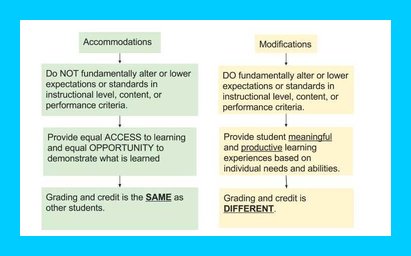More and more kids with Williams syndrome are accessing and participating in the general education curriculum. We continue to educate the educators on the learning profiles of students with WS, and they are able to implement appropriate accommodations that allow the child to access the curriculum or respond to the curriculum in a different way.
Many times the terms accommodation and modification are used interchangeably. This is wrong - they are two very different things. It is important to understand the difference between an accommodation and a modification.
Accommodations can be very helpful to students. They are adjustments made to help students "access" the curriculum. They do not impact the student’s ability to receive full credit for a class or their eligibility for graduation. Modifications, however, mean that the content of the class has been “significantly” altered in such a way that it impacts the teacher’s ability to grade the student in the same way as other students.
Here is a great explanation from www.washington.edu
The term "accommodation" may be used to describe an alteration of environment, curriculum format, or equipment that allows an individual with a disability to gain access to content and/or complete assigned tasks. They allow students with disabilities to pursue a regular course of study. Since accommodations do not alter what is being taught, instructors should be able to implement the same grading scale for students with disabilities as they do for students without disabilities. Examples of accommodations include:
- Sign language interpreters for students who are deaf
- Text-to-speech computer-based systems for students with visual impairments or Dyslexia
- Extended time for students with fine motor limitations, visual impairments, or learning disabilities
- Large-print books and worksheets for students with visual impairments
- Trackballs and alternative keyboards for students who operate a standard mouse and keyboard
The term "modification" may be used to describe a change in the curriculum. Modifications are made for students with disabilities who are unable to comprehend all of the content an instructor is teaching. For example, assignments might be reduced in number and modified significantly for an elementary school student with cognitive impairments that limit his/her ability to understand the content in the general education class in which they are included.
A key point is the “change in the curriculum.” Generally speaking, the change results in a vast reduction in the content - they are completing less than 60% of the regular work or perhaps student in one grade are completing the work that is typical for a lower grade (a student is in 6th grade and working on 4th grade math). It is very common for children with Williams syndrome to be working on a different “grade level” or “instructional level” than the actual grade they are in, especially in math.
Reducing content is another thing entirely. Content reduction can be a slippery slope OR it can be a perfect solution to ensure that a student is being taught the “gist” of a lesson and is able to demonstrate that learning. For example, if the general education content is reduced to 60% of what is given to everyone else and the student gets all of it correct, they have earned the equivalent of a “real” D on the assignment. However, if they get anything wrong, they will have failed the assignment. Multiple failed assignments mean they have failed the class. It is very important that everyone has a clear understanding of what is being reduced and what the criteria is for the reduction.
Sometimes, cherry-picking the content for the “essential concepts” is a great way to ensure that a child is held accountable for learning the important bits and not penalized for not being able to learn “everything.” Again, this is often a modification and the entire IEP team should agree on the terms of the modification and outline these in the IEP.
Graphically, it looks something like this:

For more information, please see this publication from Wright’s Law. Understanding the difference between accommodations and modifications is essential to understanding exactly what your child's educational team is suggesting for your child.
